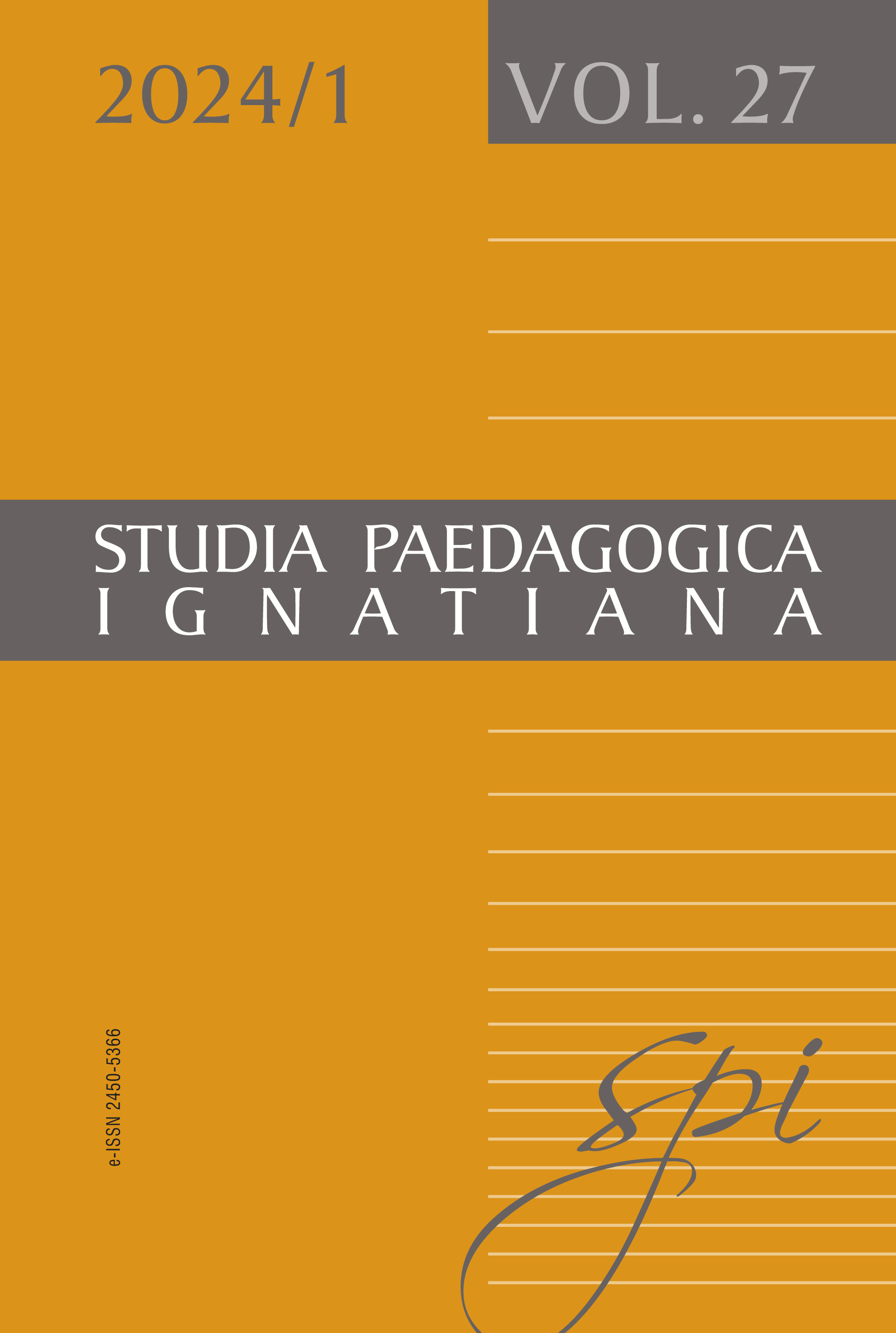Koncepcja strategii jakości noetycznych jako przykład metody projektowania wsparcia rozwoju odporności psychicznej dzieci i młodzieży
DOI:
https://doi.org/10.12775/SPI.2024.1.002Słowa kluczowe
noodynamika, noetyczny wymiar osobowości, strategia jakości noetycznych, logoprofilaktyka, profilaktykaAbstrakt
Celem artykułu jest przedstawienie autorskiej koncepcji strategii jakości noetycznych jako metody wsparcia rozwoju odporności psychicznej dzieci i młodzieży. Problem badawczy dotyczy odpowiedzi na pytanie: czy i w jaki sposób strategię jakości noetycznych można wykorzystać w profilaktyce jako metodę wsparcia rozwoju odporności psychicznej dzieci i młodzieży oraz jakie praktyczne implikacje wynikają z założeń strategii. W artykule zastosowano metodę analityczno-syntetyczną badania literatury przedmiotu.
Na podstawie opracowań literatury przedmiotu przeprowadzono analizę zależności pomiędzy noetycznym wymiarem osobowości a odpornością psychiczną oraz dokonano procesu konceptualizacji strategii jakości noetycznych. Przedstawiono miejsce i znaczenie autorskiej strategii w profilaktyce oraz określono praktyczne implikacje wynikające z jej założeń.
Z przeprowadzonych analiz wynika, iż jakości noetycznego wymiaru osobowości są czynnikami chroniącymi dla jednostek w sytuacjach trudnych. Wyznaczone cele oraz mechanizm działania strategii jakości noetycznych opiera się na strukturze noodynamiki Kazimierza Popielskiego. Koncepcja strategii jakości noetycznych daje teoretyczne podstawy do poszukiwania wdrożeń praktycznych dla profilaktyki i logoprofilaktyki. Ukazuje ona sposoby wzmacniania i rozwoju osobowości w noetycznym wymiarze, co w znaczący sposób może przyczyniać się do wspierania rozwoju odporności psychicznej jednostek. Może być ona wykorzystywana do budowy programów profilaktycznych skierowanych do dzieci i młodzieży.
Bibliografia
Antonovsky A. (1995). Rozwikłanie tajemnicy zdrowia. Jak radzić sobie ze stresem i nie zachorować, trans. H. Grzegołowska-Klarkowska, Warszawa: Instytut Psychiatrii i Neurologii.
Benard B. (2004). Resiliency: What We Have Learned, San Francisco (CA): WestEnd.
Frankl V.E. (1978). Homo patiens, trans. R. Czernecki, J. Morawski, Warszawa: Instytut Wydawniczy Pax.
Frankl V.E. (2009). Człowiek w poszukiwaniu sensu, trans. A. Wolnicka, Warszawa: Wydawnictwo Czarna Owca.
Frankl V.E. (2010). Wola sensu. Założenie i zastosowanie logoterapii, trans. A. Wolnicka, Warszawa: Wydawnictwo Czarna Owca.
Gaś Z.B. (2004). Szkolny program profilaktyki: istota, konstruowanie, ewaluacja. Poradnik metodyczny, Lublin: Pracownia Wydawnicza Fundacji „Masz Szansę”.
Gąsior K. (2012). Funkcjonowanie noo-psychospołeczne i problemy psychiczne dorosłych dzieci alkoholików, Warszawa: Difin SA.
Gubała T. (2022). “CUDER czyli jak pokazać integrację osoby,” Wychowawca, July–August 2022, pp. 12–13.
Grzelak S. (2015). Vademecum skutecznej profilaktyki problemów młodzieży. Przewodnik dla samorządowców i praktyków oparty na wynikach badań naukowych. Jak wspierać młodzież w podróży życia?, Warszawa: Ośrodek Rozwoju Edukacji.
Jarosz K. (2019). Profilaktyka pozytywna w teorii i praktyce pedagogicznej, Opole: Wydawnictwo Uniwersytetu Opolskiego.
Jarosz K. (2022). “Model wielowymiarowej profilaktyki pozytywnej jako przykład narzędzia projektowania wsparcia rozwoju duchowości dzieci i młodzieży,” Horyzonty Wychowania, vol. 21, no. 58, pp. 78–89.
Junik W. (2011). “Zjawisko rezyliencji – wybrane problemy metodologiczne,” [in:] W. Junik (ed.), Resilience, Warszawa: Wydawnictwo Edukacyjne Parpamedia, pp. 89–99.
Klamut R. (2002). Cel, czas, sens życia, Lublin: Towarzystwo Naukowe KUL.
Kmiecik-Jusięga K. (2022). “Logoprevention: A New Concept of Prevention of Risky Behaviors in Children and Adolescents Based on the Assumptions of Victor E. Frankl’s Logotherapy,” Studia Paedagogica Ignatiana”, vol. 25, no. 4. pp. 19–32.
Okulicz-Kozaryn K. (2003). “Teorie psychologiczne w praktyce profilaktycznej,” Remedium, no. 12(120), pp. 36–37.
Ostaszewski K. (2006). “Profilaktyka pozytywna,” Świat Problemów, vol. 3, no. 158, pp. 6–10.
Ostaszewski K. (2010). “Kompendium wiedzy o profilaktyce,” [w:] J. Szymańska (ed.), Przewodnik metodyczny po programach promocji zdrowia psychicznego i profilaktyki, Warszawa: Etoh Fundacja Rozwoju Profilaktyki, Edukacji i Terapii Problemów Alkoholowych, pp. 73–97.
Ostaszewski K. (2014). Zachowania ryzykowne młodzieży w perspektywie mechanizmów resilience, Warszawa: Instytut Psychiatrii i Neurologii.
Popielski K. (1994). Noetyczny wymiar osobowości. Psychologiczna analiza poczucia sensu życia, Lublin: Redakcja Wydawnictw KUL.
Popielski K. (2008a). Psychologia egzystencji. Wartości w życiu, Lublin: Wydawnictwo KUL.
Popielski K. (2008b). “Noetyczne jakości życia i ich znaczenie w procesie ‘bycia i stawania się’ egzystencji,” „Chowanna”, no. 1, pp. 9–25.
Popielski K., Mamcarz P. (2015). Trauma egzystencjalna a wartości, Warszawa: Difin SA.
Solecki R. (2022). “Logoprofilaktyka,” Wychowawca, July–August 2022, pp. 13–14.
Suchocka L. (2007). Psychologiczna analiza cierpienia w chorobie przewlekłej, Lublin: Towarzystwo Naukowe KUL.
Werner E., Smith R. (1992). Overcoming the Odds: High Risk Children from Birth to Adulthood, New York: Cornell University Press.
Pobrania
Opublikowane
Jak cytować
Numer
Dział
Licencja
Prawa autorskie (c) 2024 Katarzyna Jarosz

Utwór dostępny jest na licencji Creative Commons Uznanie autorstwa – Bez utworów zależnych 4.0 Międzynarodowe.
Autor zgłaszając swój artykuł oświadcza, że:
jest Autorem artykułu (zwanego dalej Utworem) i:
- przysługują mu wyłączne i nieograniczone prawa autorskie do Utworu,
- jest uprawniony/a do rozporządzania prawami autorskimi do Utworu.
Udziela Uniwersytetowi Ignatianum w Krakowie nieodpłatnej, niewyłącznej, nieograniczonej terytorialnie licencji do korzystania z Utworu na następujących polach eksploatacji:
- utrwalania utworu w formie papierowej, a także na nośniku cyfrowym lub magnetycznym;
- zwielokrotnienia utworu dowolną techniką, bez ograniczenia ilości wydań i liczby egzemplarzy;
- rozpowszechniania utworu i jego zwielokrotnionych egzemplarzy na jakimkolwiek nośniku, w tym wprowadzenia do obrotu, sprzedaży, użyczenia, najmu;
- wprowadzenia utworu do pamięci komputera;
- rozpowszechniania utworu w sieciach informatycznych, w tym w sieci Internet;
- publicznego wykonania, wystawienia, wyświetlenia, odtworzenia oraz nadawania i reemitowania, a także publicznego udostępniania utworu w taki sposób, aby każdy mógł mieć do niego dostęp w miejscu i czasie przez siebie wybranym;
- w zakresie praw zależnych do Utworu, obejmujących w szczególności prawo do dokonania koniecznych zmian w Utworze, wynikających z opracowania redakcyjnego i metodycznego, a także do dokonania tłumaczenia Utworu na języki obce.
Udzielenie licencji następuje z chwilą przekazania Utworu na rzecz Uniwersytetowi Ignatianum w Krakowie. Uniwersytet Ignatianum w Krakowie jest uprawniony do udzielania dalszych sublicencji do Utworu, w zakresie udzielonego prawa. Licencja jest ograniczona czasowo i zostaje udzielona na okres 15 lat, licząc od daty jej udzielenia.
Polityka prywatności
Statystyki
Liczba wyświetleń i pobrań: 1109
Liczba cytowań: 0



